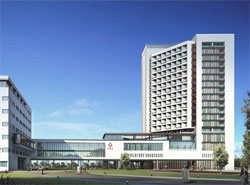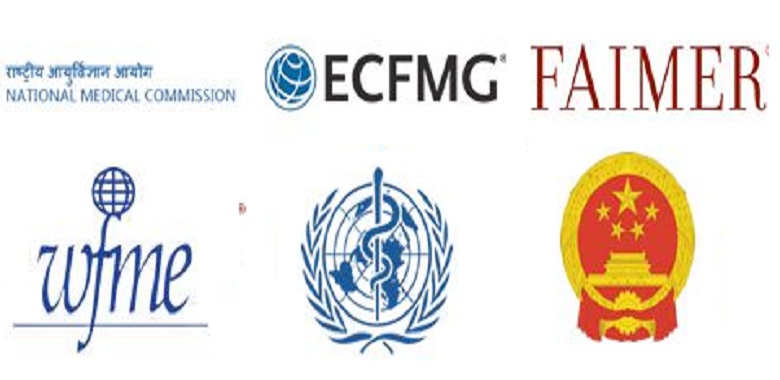
 Southeast University is a public research university located in Nanjing, Jiangsu Province, China. It is one of the oldest universities and the first coeducational university in China. It is a member of both Project 985 and Project 211, and sponsored by the Ministry of Education of China aiming to become a well-known world-class university. SEU has been ranked among the top 20 research universities in China, and among the top 500 in the world. In the official subject ranking conducted by the Ministry of Education of China, SEU has been ranked top three nationally in 8 fields including architecture, landscape architecture, urban planning, art history, civil engineering, electronic engineering, transportation engineering and biomedical engineering.
Southeast University is a public research university located in Nanjing, Jiangsu Province, China. It is one of the oldest universities and the first coeducational university in China. It is a member of both Project 985 and Project 211, and sponsored by the Ministry of Education of China aiming to become a well-known world-class university. SEU has been ranked among the top 20 research universities in China, and among the top 500 in the world. In the official subject ranking conducted by the Ministry of Education of China, SEU has been ranked top three nationally in 8 fields including architecture, landscape architecture, urban planning, art history, civil engineering, electronic engineering, transportation engineering and biomedical engineering.
Its predecessor, Sanjiang Normal College, was established in 1902 as a modern university on the campus of an academy which dates back to 258. In 1921, the school changed its name to National Southeast University and became the second national university in China. Later SEU was renamed to National Central University in 1927 and soon became the nation’s flagship university. In 1952, the university was split into eight institutions during the communism revolution. And its engineering school, the largest school in terms of faculty number and student enrollment, stayed in its original campus and form Nanjing Institute of Technology, which changed its name back to Southeast University in 1988. Southeast University is one of only 32 universities directly administered by the Chinese Department of Education, which are considered the top class universities in China. The university has 16,000 undergraduate students and 10,000 graduate students in over 30 schools and departments. The university has 64 undergraduate programs, 206 master programs, 109 doctoral programs, as well as 15 postdoctoral research sites.
There are 3 main campuses of Southeast University namely Sipailou Campus, Jiulonghu campus and Dingjaiqiao campus. Sipailou and Dingjiaqiao campus are in Nanjing city and Jiulonghu campus in suburbs of Nanjing.
 In February 1903, the following Liangjiang governor Zhidong Zhang submitted a proposal to open Sanjiang Normal College to government, and authorize Quansun Miu as a representative to Japan for investigation, who later was norminated as the inspector of Sanjiang Normal College and responsible for the project preparation. In September 1903, Sanjiang Normal College was officially started. Due to the ambiguous meaning of the college name which led to several disputes, the Sanjiang Normal College was named as Liangjiang Normal College in 1905. At the end of 1911, due to the breaking out of Xinhai Revolution, Liangjiang Normal College was almost closed. On 10 September 1915, Nanjing Higher Normal School was officially started. In December 1919, Nanjing Higher Normal School formally recruited 8 female students and 50 more female visiting students, being the first school in China allowing both females and males to study together.
In February 1903, the following Liangjiang governor Zhidong Zhang submitted a proposal to open Sanjiang Normal College to government, and authorize Quansun Miu as a representative to Japan for investigation, who later was norminated as the inspector of Sanjiang Normal College and responsible for the project preparation. In September 1903, Sanjiang Normal College was officially started. Due to the ambiguous meaning of the college name which led to several disputes, the Sanjiang Normal College was named as Liangjiang Normal College in 1905. At the end of 1911, due to the breaking out of Xinhai Revolution, Liangjiang Normal College was almost closed. On 10 September 1915, Nanjing Higher Normal School was officially started. In December 1919, Nanjing Higher Normal School formally recruited 8 female students and 50 more female visiting students, being the first school in China allowing both females and males to study together.
On 6 June 1921, the Board of Southeast University was established, Guo Bingwen as president, and the university was officially opening in September. In December, the school council decided that Nanjing Higher Normal School would be incorporated into the Southeast University. Southeast University, based on the foundation of Nanjing Normal Higher School, until 1923, had possessed arts and sciences, Education, engineering, agriculture, business totaling more than 20 lines in 5 subjects. In 1924, the engineering school of National Southeast University merged with the water conservancy school Hohai Engineering School to form National Hohai Technology University. In 1927, National Hohai Technology University along with several other schools merged with National Southeast University to form the later National Central University.
At the beginning of 1949, many professors refused to move the campus to Taiwan. In April 1949, the People Liberation Army occupied Nanjing and the Nanjing Military Committee took over the National Central University. On Aug, 8th, 1949, The name of National Central University was changed to National Nanjing University, until October 1950, the name was changed to Nanjing University again. In 1952, People’s Republic of China began a national adjustment of its colleges. In Nanjing, the adjustment was mainly on Nanjing University and University of Nanking.
Nanjing Institute of Technology was formed in the original site of National Central University from the previous Engineering Department (at the time, the biggest department) of Nanjing University and Agriculture Department of University of Nanking, also including Chemistry Department and Electrical Machine Department. Later there were also some relevant subjects from Jiaotong University, Zhejiang University, Shandong University, Xiamen University, Fudan University, and Private Jiangnan University merged into Nanjing Institute of Technology. In June 1988, Nanjing Institute of Technology was renamed as ‘Southeast University’, starting to convert from a technology institute to a technology-featured comprehensive university.
| Basic Eligibility | 70 % in PCBE in 10+2 |
| NEET Entrance Test | Yes, with qualifying marks |
| Course Fees | INR 4.15 Lakhs per year approx. |
| Duration of Course | 5+1 Years |
| Medium of Instruction | English |
| University Recognition | Approved by NMC and WHO |
This university is accredited by ministry of health and education which indicates the fact that this is one of the universities which has global recognition of it’s MBBS degree.

Key Features of the University
The university has several undergraduate programs, postgraduate programs, doctoral programs along with study centres for post-doctoral studies as well in different fields of medicine. The university has a total of 7 affiliated hospitals that are Nanfung Hospital, Zhujiang Hospital, Hua’nan Hospital, Nanhua Hospital, Stomatology Hospital, Pingxiang Hospital, Jiangdu Hospital and Xinhui People’s Hospital With its first class teaching methodologies, the university is undoubtedly the top destination of MBBS studies. In an addition to this, its low MBBS fees in China necessarily make sure those aspirants from all over the world especially the Indian students to opt for China MBBS in the Southern Medical University.
Faculties and Departments
Southern Medical University takes pride in having a total of 19 schools for medical study in China that are as listed below.
- The First Clinical Medical School (Nanfang Hospital)
- The Second Clinical Medical School (Zhujiang Hospital)
- School of Basic Medical Sciences
- School of Pharmaceutical Sciences
- School of Traditional Chinese Medicine
- School of Laboratory Medicine and Biotechnology
- School of Nursing
- School of Biomedical Engineering
- School of Stomatology
- School of Health Management
- School of Rehabilitation
- School of Forensic Medicine
- School of Health Management
- School of Public Health and Tropical Medicine
- General Education Department
- School of Foreign Studies
- School of Marxism Study
- Graduate School
- School of Continuing Education
World Ranking
Southern Medical University ranks 626 in the world.
Country Ranking
The country rank of China Medical University is 49 for medical education in China which clearly proves it ranks among the top medical universities of China.
Why Choose Southern Medical University to Study Medicine?
There are a number of reasons as to why Southern Medical University would certainly be a very good choice for MBBS admission in China that are as mentioned below.
- No Donation Required for MBBS admission in this University.
- Direct MBBS admission to the university.
- Advanced Teaching Methodologies.
- Low Fees Structure.
- Indian Food Available.
- Low cost accommodation.
- Fully English Medium.
- Advanced hospitals for studies as well as internship.
- One of the best Medical University of China.
Duration of MBBS in Southern Medical University
The overall duration of medicine study in China is six years which is divided into five years of classroom studies and one year of internship once the classroom studies are completed. The students are provided with all the theoretical as well as practical training from the classroom studies. The internship helps the students in getting hands on experience in operations, surgeries and all other relevant trainings that are necessary.
Deadlines or Timelines for Admissions
To study medicine in China in the Southern Medical University, the deadline for admission is 15th of July of each year and the intake of China MBBS admission starts in the month of September.
Admission Procedure for MBBS in Southern Medical University
China medical universities have a completely smooth and uninterrupted admission process. To get a better idea of the overall process of admission, please read through.
- The admission process starts with filling up the application form required studying medicine in China along with the prescribed documents.
- Then the candidates need to pay the application fees, admission fees and the processing fees. The fees for application as well as admission are to be paid in advance and the processing fees can be either sent to China or India whichever is earlier.
- Within seven to ten working days after the fees are paid, the candidates can expect to receive the official photocopy of the admission letter issued by the university.
- The next step involves sending the documents to the Ministry of Education in China for processing. This is essential for the issuance of the JW2O2 form without which the Chinese Embassy would not process a student visa for MBBS admission China.
- Within a time period of about 30 days, the admission letter is received and the issuance of the Chinese is complete which ends the process of admission to MBBS abroad China.
Eligibility for MBBS in Southern Medical University
MBBS in China eligibility for getting admission to Southern Medical University to apply for an MBBS seat in China are as mentioned below.
- To study medicine in China, the upper age limit is 25 and 17 is the lower age limit.
- Physics, Chemistry and Biology be necessarily a part of the curriculum of the applicants in the Plus 2 level who plan to study in China
- 70 percent and above score is required in Physics, Chemistry and Biology.
- To study medical in China, the candidates require having studying experience of two years of all the three subjects.
- Clearing NEET is essential with qualifying marks.
- An IELTS or TOEFL score is required.
- Good fluency in English is required so that the students can communicate freely.
Documents Required
For MBBS education in China in the Southern Medical University, the students are required to keep the following documents handy.
- Form of application
- Passport size photo
- Mark sheets of class 11 and 12 from the respective board of education
- Certificates of class 11 and 12 from the respective board of education
- School leaving certificate
- Scanned copy of a valid passport including image
- Certificates of extracurricular activities if any
- All the documents should be attested and notarized form the relevant authorities
Additionally, the following documents are required for visa application.
- A valid passport of the applicant
- Recent coloured passport sized photographs
- Visa application form
- The JW2O2 form which is also required in original at the time of coming to China
- Letter of admission issued by the university
- Physical examination form or the health check-up form
Accommodation
International students may choose to live in the International Students’ Dormitary, which spread in all three campuses – 1. Dingjiaqiao Campus 2. Jiulong Lake Campus 3. Sipailou Campus. SEU’s Int’l Students Dorms are scattered around Sipailou Campus, Dingjiaqiao Campus and Jiulong Lake Campus. Currently, most of the first-year students live at Jiulong Lake Campus; most of the medical students live at Dingjiaqiao Campus and the students of other majors live at Sipailou Campus. The room facilities in the 3 int’l student’s dorms are similar including air conditioning, water heater for shower, 2 beds, desks, chairs, cupboards, telephone, Internet access and bathroom. And self-supplied mini kitchens are available at the dorms at Sipailou and Dingjiaqiao campuses. International students can have their dinner at school cafeterias or nearby restaurants.
Southern Medical University Fees Structure
| Particulars | Tuition Fee / Year | Hostel Fee /Year |
|---|---|---|
| Fees In US Dollars | 33000 RMB | 6000 RMB |
| Fees In Rupees (INR) Approx. | 3,30,000 Rupees/yr. | 60,000 Rupees/yr. |
